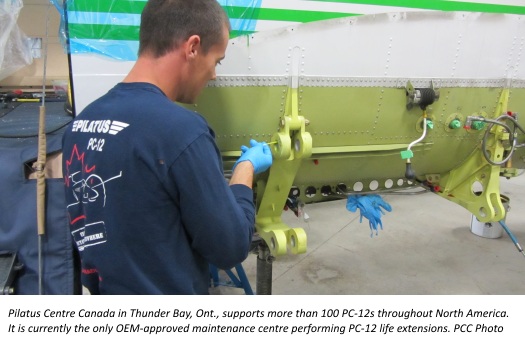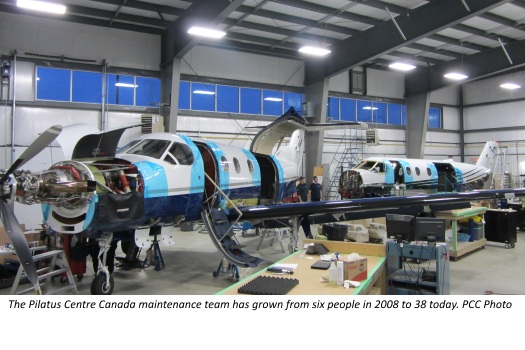Estimated reading time 4 minutes, 47 seconds.

Canada’s Pilatus PC-12 single-engine turboprops are among the hardest-working aircraft of their kind. Ninety-five of the world’s 1,292 PC-12s are currently flying here, serving in a variety of roles from medevac to executive transport to scheduled commercial service.
The Canadian aircraft were the first to approach a major PC-12 service bulletin requirement at 20,000 hours or 27,000 landings. Pilatus Centre Canada (PCC) of Thunder Bay, Ont., is the exclusive Canadian sales and service centre for Pilatus aircraft. It is also the only certified maintenance centre in the world currently approved by Pilatus to carry out a two-part PC-12 life extension program—jointly developed by Pilatus and PCC—that extends the hourly life of the aircraft by 2.5 times its original 20,000 hours.
PCC maintenance staff completed their first PC-12 life extension in 2008; today, they are working on their 13th, with another planned for the spring.
Service Bulletin 04-009, known as LEP1 (Life Extension Program 1), is performed at 20,000 hours or 27,000 landings. It is the first major tear-down inspection in the life of these aircraft; therefore, engineers are looking for corrosion and wear and tear to doors and frames, flight control systems, and wiring, among other issues. If required, the engine and prop will be sent to approved maintenance organizations for repair or overhaul.
“We remove the interior, floors, windows, landing gear, engine, wings, tail and flight controls,” explained Steve Davey, executive vice president and director of maintenance at PCC. “After cleaning out the debris and corrosion protection materials, we spend at least four weeks carrying out in-depth visual and NDT (non-destructive testing) inspections.”
Once the inspection is completed, repairs are carried out. Passenger and cargo door areas often need repair, as well as any fuselage skins that have been damaged by unpaved runways or through typical operations. Part of the service bulletin includes the replacement of primary attaching hardware such as the wing-fuselage attachments on both the fuselage and the wing. Windows are removed, inspected and refurbished if necessary. Landing gear inspection includes NDT, and axles or components are checked for damage or wear. The entire aircraft and its systems are inspected in great detail. In all cases, if these items do not meet the appropriate design criteria, they are repaired or replaced. All repairs are done in conjunction with a factory engineering review.
The service bulletin requires 100 days of shop time at a cost of approximately US$275,000. Two years prior to the estimated time for the service bulletin, PCC will contact PC-12 owners to plan for both the mandatory service bulletin and any optional work that can be done consecutively. LEP1 positions are booked at PCC six months prior to the commencement of the project.

“We are usually doing other customer work when the aircraft is down for the inspection, as they will delay some optional maintenance work until the aircraft is tied up for the service bulletin,” continued Davey. “This might be an avionics upgrade, the replacement of worn seat tracks, or a completely refurbished interior.”
Once LEP1 and all additional work is concluded, the aircraft is turned over from the heavy maintenance crew to the line maintenance crew, which carries out an annual inspection, thereby providing another level of quality assurance.
The second part of the PC-12 life extension is LEP2, due at 25,000 hours or 30,000 landings. LEP2 consists of supplemental structural inspections as defined in the PC-12 maintenance manual. These inspections are repeated at various intervals until the aircraft reaches retirement at 50,000 hours or 60,000 landings.
PCC has been in growth mode for the past few years, increasing its maintenance team from six people in 2008 (when they started performing PC-12 life extensions), to 38 today. The Thunder Bay shop supports more than 100 PC-12s throughout North America, and will likely take on a good percentage of coming PC-12 life extensions. As well, PCC has been named as the Canadian service centre for the new PC-24 twin-jet. Certification and first customer deliveries will occur in 2017, with PC-24s expected to be operating in Canada by 2018.








